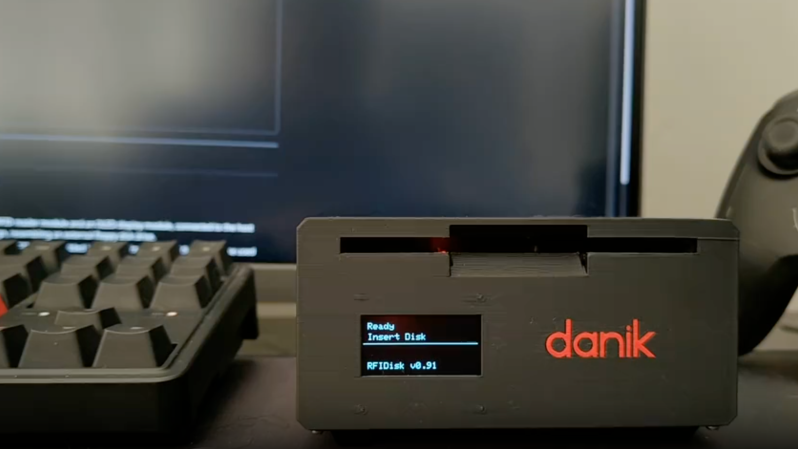Not too long ago, part of using a computer was often finding the correct disk for the application you wanted to run and inserting it into your machine before you could start. With modern storage, this is largely a thing of the past. However, longing for some of that nostalgia, [ItsDanik] has been developing the RFIDisk, a 3D printed floppy drive that can kick off applications when their disk is inserted.
The desktop enclosure is printed to look like a standalone floppy drive, allowing use with either desktops or laptops. There’s the familiar 3.5 inch slot ready for your floppy disk, and there’s also a 1.3 in. OLED display on the front giving you feedback on the status of the RFIDisk — including telling you what’s currently inserted. Inside the enclosure is an Arduino Uno and an MFRC522 RFID reader. As the name would suggest, the way the RFIDisk enclosure reads its media is via NFC, not the traditional magnetic reader. Due to being RFID-based, the disks printed for the RFIDisk are solid without moving parts, but enclose a 25 mm NTAG213 NFC tag.
On the software side, [ItsDanik] has developed the RFIDisk Manager Python application, which is used to tie specific NFC tag IDs to commands to run when that tag is read. The application includes some nice features, such as being able to adjust the commands for both when the disk is first read and when it’s removed from the RFIDisk. You can also change what shows up on the OLED screen when the cartridge is inserted.
Using NFC to simulate physical media is a clever trick we’ve seen before, but if you’re looking for something with a bit more physical engagement, you could always put your USB devices into 3D printed cartridges.
















there was a kind of similar idea where someone had made a music album player that read nfc cards with the album cover printed on them to help older people play music easier on the usual streaming services. it’s a neat idea for an interface
Sounds like Zaparoo which is used on the Mister FPGA
💯There’s even an image on the Zaparoo website of someone who built it into a floppy drive. I’ve honestly considered doing this myself with one of my old floppy disk drives and stacks of floppy discs I could stick rfid stickers on.
It reminds me the way actual data tapes are made: asides the data stored on the magnetic tape itself, the cartridge also contains a small RFID in which are stored the tape serial number and tape usage statistics.
So at first I though that this system would take benefit of an added RFID chip to use data store in cache instead of reading physically the floppy.
Would be neat to have a floppy drive interface with an SD card holding disk images. Then use the user interface (display+buttons or NFC) to select which floppy image to present. BlueSCSI for floppy drives?
https://lotharek.pl/productdetail.php?id=41
Sooo… weird/useless “Security through Obscurity” idea:
Shoehorn the RFID reader in a functional drive; hide an RFID tag inside a functional disk; write a bogus key data into the disk, and an identification on the disk’s RFID tag.
Use the RFID tag as a security token of sorts (read when you stick it into the drive), and let everybody think that the key info is in the disk file. If someone copy the disk to get the key, will get nonsense useless garbage.
…or use a real encription and avoid all the fuss, but what’s the fun?
(on a sidenote – maybe I’ll shoehorn an RFID tag into a real floppy disk, and trick my friends into thinking my phone can actually read disks only by touching it… lol…)
Cool, this is a separate effort from Mar Bartolome’s RFID floppy. The trend is picking up.
If you were really into the vintage feel without the vintage waiting…
Build it into a real floppy drive. The NFC tag only contains a unique identifier.
When you insert a floppy for the first time it reads the whole thing and stores it on an internal ssd, indexed by the key in the NFC tag. On subsequent inserts you are just working from the stored image.
Similar concept to the Yoto – an ebook reader for young children that uses physical cards as the UX. The child picks a card from their collection (based on the cover art) and inserts it into the machine. The machine identifies the card and then plays the corresponding ebook from the cloud.
To really scratch my nostalgia itch, I would use N64 cartridges instead of floppies. That has the added bonus that the label stays visible while inserted, so you can skip the LCD part of the project.
“…the way the RFIDisk enclosure reads its media is via NFC”– Actually, I don’t think you could call it “reading its media”, as the computer is only registering an NFC connection. It’s more like reading a command, but not quite even that– more like reading a code which represents a command.